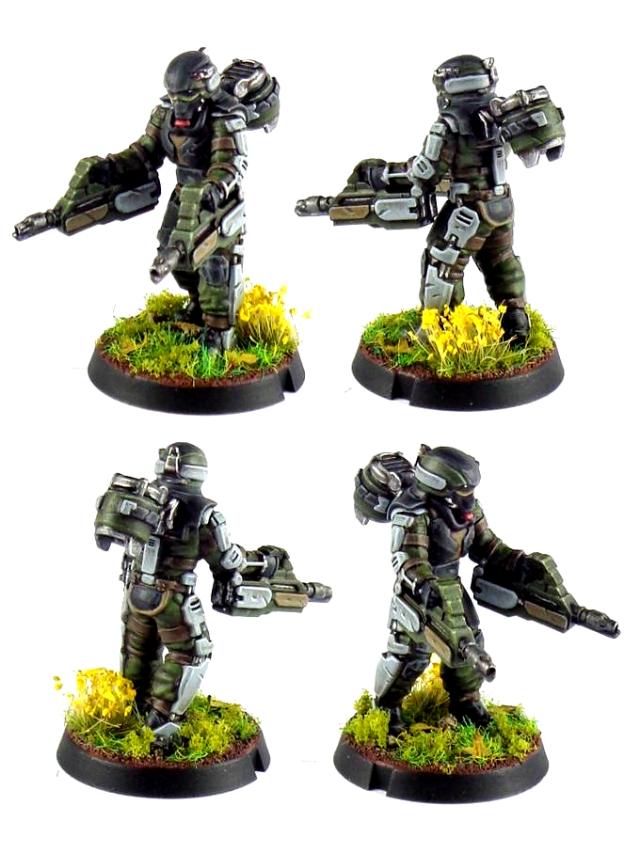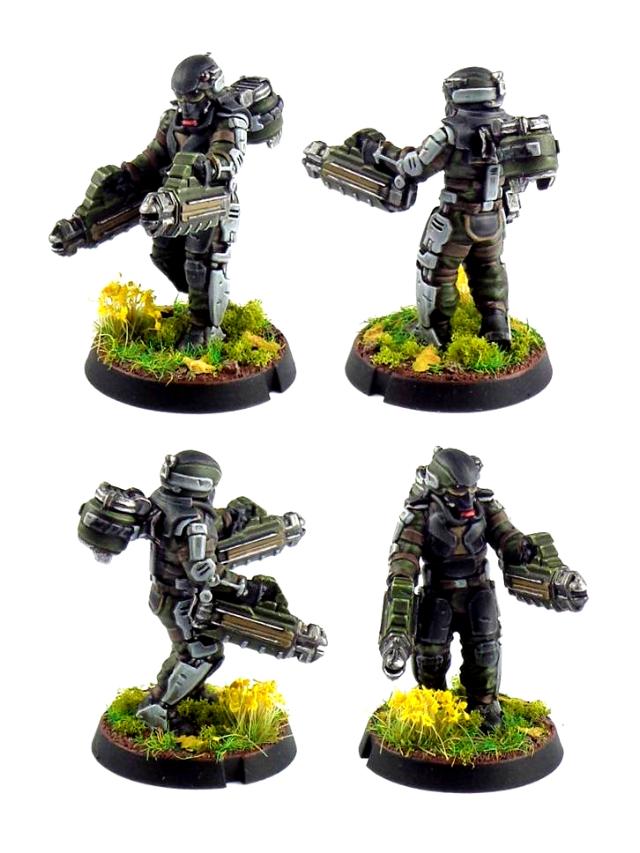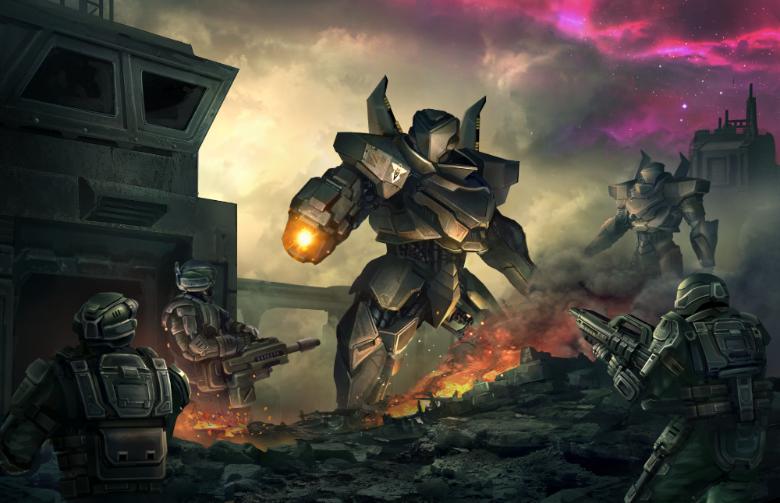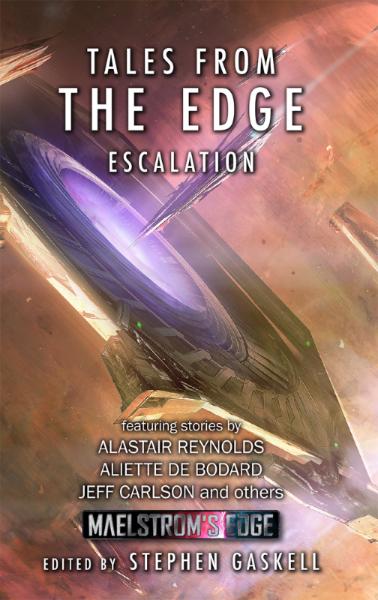Download the Maelstrom's Edge Rulebook for free!
Posted on Wednesday Apr 24, 2019 at 05:00pm in Gaming
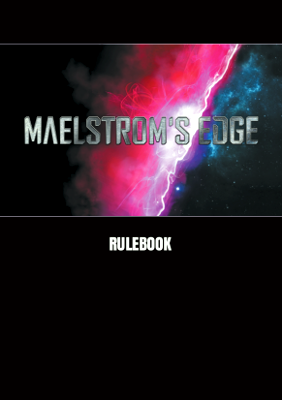 With work underway for a revised 'Version 2' of the Maelstrom's Edge rules, the current rulebook is now being offered for free download in PDF form! You can download it from here.
With work underway for a revised 'Version 2' of the Maelstrom's Edge rules, the current rulebook is now being offered for free download in PDF form! You can download it from here.
The Maelstrom's Edge Digital Rulebook is a 144 page PDF document containing the background lore of the Maelstrom's Edge universe and the rules for the game, with scores of photographs and diagrams. The document has a complete bookmark structure and clickable links in both the index and in-text references, so you can quickly navigate your way through the rules. The contents of the digital rulebook are identical to those in the printed rulebook found in the box set.
The Maelstrom's Edge Rulebook features the following content:
- The Universe of Maelstrom's Edge
- The Factions
- Game Overview
- Core Game Concepts
- Characteristics, Versus Rolls & Suppression
- Movement & Terrain
- Shooting & Cover
- Unit Activation & Actions
- Charge Action
- Model Type
- Large Models
- Weapon & Unit Abilities
- Buildings
- Playing a Game
- Mission Objectives
- Selecting Your Force
- Narrative Missions
- Forces of the Epirian Foundation
- Forces of the Karist Enclave
- Appendices
- Rules Finder
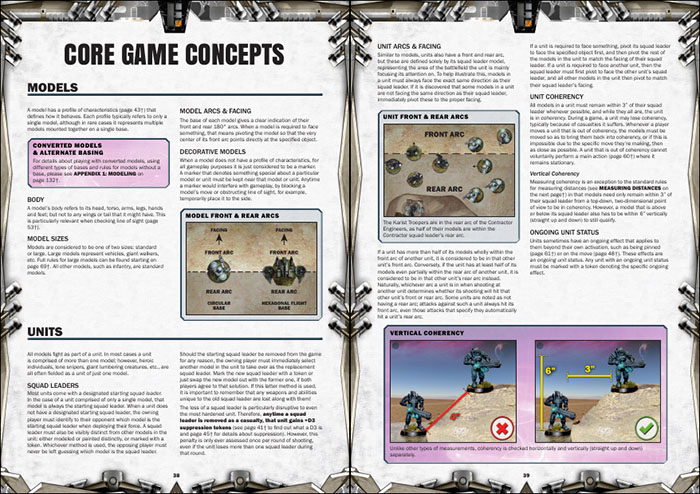
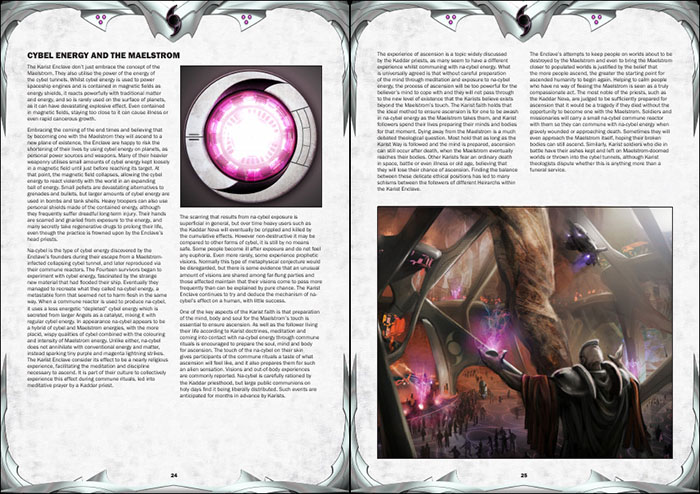
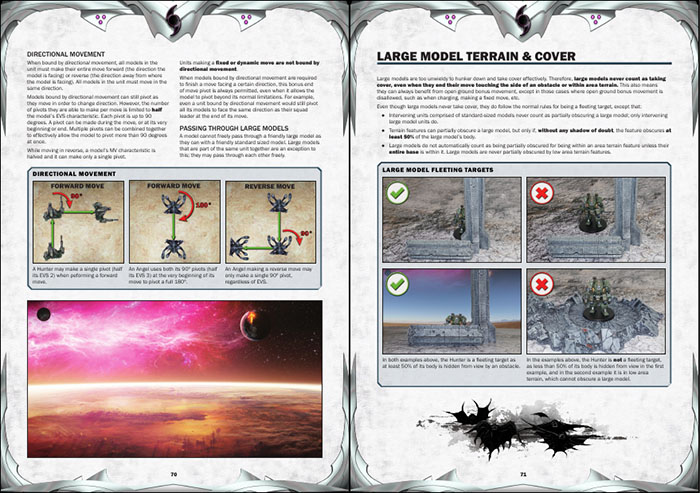
Download it here.
Terrain Spotlight: 'Illuminated' Viewscreen
Posted on Tuesday Apr 23, 2019 at 05:31am in Tutorials
I'm home from Salute (which was a blast!) and a regrettably very short stay in London, and now getting caught up on everything. As a result, this week's modeling article is a short and sweet one, which also creates a little more progress on my landing pad display board. One of the features I wanted to add on was a viewscreen displaying a 'Welcome' message to new arrivals to the pad. I wanted this to give the illusion of being an illuminated screen without actually having to resort to playing around with LEDs and the like, and below is a quick rundown on how I set this up.
The frame for the viewscreen was made from a garage door from the Maelstrom's Edge terrain sprue. I cut the door out with a razor saw, and then sliced up the doorframe and rearranged it into a smaller rectangle. (You could also just use a rectangle of thick plasticard with the middle cut out!) This was then painted using my normal weathered metal technique.
I wanted the back of the screen to be slightly smaller than the frame, so that the viewscreen would look like it was sitting out slightly from the wall rather than having the sides sit flush against it. So I traced around the frame onto a piece of thin plasticard, and then it cut out about 1.5mm inside the line to make it smaller than the tracing. I then glued this piece to the back of the frame, and painted around the outside edge with some Vallejo Heavy Charcoal so there wouldn't be any white peeking out from behind once it was mounted on the wall.
For the image on the screen, I grabbed an appropriate picture and added some text in Gimp, before printing it out at an appropriate size on glossy photo paper.
I sprayed the picture with a light coat of gloss sealer to protect it, and then glued it in place inside the frame.
To give the illusion of a glow, I painted around the inside edge of the frame with silver, and then added a couple of coats of brush-on gloss varnish. The gloss creates a dull reflection around the edges of the frame - it's a subtle effect, but enough to convey the idea of a low-powered screen that doesn't throw out a lot of excess light.
An alternative to this effect would have been to paint around the inner edges of the frame with colours matching the adjoining parts of the picture. This can create a much brighter 'glow' than the method I've used above, but can also look off if you look at it from the wrong angle.
With that done, it's time to get cracking on the rest of the display board, since I'm getting rather impatient to see it finished!
Build your own viewscreen by picking up the Maelstrom's Edge terrain sprue, along with the rest of the Maelstrom's Edge model range from the webstore here.
As always, feel free to pop along and share your work, or ask any Maelstrom's Edge- or hobby-related questions on the Comm Guild Facebook page!
For other Maelstrom's Edge modeling articles, including tutorials and walkthroughs of a wide range of different building and miniature projects, check out the Hobby section of the Maelstrom's Edge website here.
Tags: modeling painting spotlight terrain terrainsprue tutorial walkthrough
Team Building!
Posted on Wednesday Apr 17, 2019 at 05:00pm in The Remnant
While we were all gathered together after Salute, the Spiral Arm Studios team has been happily assembling Militus suits. There may have been some 'Pew! Pew!' noises...
The Militus kit is available now from the Maelstrom's Edge webstore!
Modeling Spotlight: Remnant Militus Battlesuit
Posted on Monday Apr 15, 2019 at 05:00pm in Tutorials
- by Iain Wilson
This month saw the release of a new faction, and a fantastic new multi-part, plastic kit for Maelstrom's Edge, in the form of the Artarian Remnant's Militus battlesuit. For this week's modeling article, I thought I would take a closer look at this kit and see what I could make with it.
The Militus kit comes with a single plastic frame, which includes one battlesuit, two each of the different ranged weapon options, fist and reflex shield options, two different shoulder pad options, two different backpack options, and more heads than you can poke a shock baton at, to allow for some very easy customisation between your different suits.
The Militus is fully articulated, with ball joints at ankles, knees, hips, elbows and shoulders, which allows for a wide range of posing options. The ranged weapons also have a multi-part gimble arrangement which allows both arm-mounted and shoulder-rig weapons to be positioned just how you want them.
As an alternative to the standard shoulder rig, you can leave the vertical arm off and flip the weapon over, attaching the gimbal directly to the shoulder pad.
As a handy extra, the connection point for the weapons onto the gimbal is a very snug fit, which actually allows you to leave the weapon unglued and just push them into place, so that you can switch between weapons as desired between games. Likewise, while the forearm-and-hand option uses a different upper arm to the ranged weapons, the shoulder joint is a tightly fitting ball and socket joint, so if you glue the shoulder pad on to the torso without gluing the arm, you can carefully wiggle the arms in and out of the shoulder socket to swap them.
The saw blades on the above suit are not from this kit, but came from a Warhammer 40000 ork vehicle, used here just because I thought it looked awesome!
The backpack options (a field generator and a jump pack) also slot on, fitting neatly over the suit's back. These aren't quite as snug as the shoulders, but you could easily leave them unglued and attach them when you want them with a little blue-tac or similar poster adhesive.
The fantastic thing about plastic, of course, is that it is simple to modify. So if the already wide range of posing available to the suit doesn't quite get it where you want it, it's an easy job to trim the joints a little to push them out even further. The below suit was posed by removing the top edges of the thigh armour plates, trimming the edges of the hip socket and leaving off the triangular piece that fits into the back of the shin.
Lorican Champions are highly individual souls, and love to customise their suits. For this reason, the frame includes a bunch of different heads, and we will be releasing a resin upgrade pack to add some extra options in the near future. You can also look at other 28mm resin add-ons for more distinctive customisation - the heads on the suits are more or less human-sized, although you may need to fill the neck socket with some putty. The below suit was customised with an assortment of resin parts I had laying around from an old grab bag. His weapon drone (representing a shoulder mounted weapo, rules-wise) was made from a chopped up jump pack.
Finally, you're likely to wind up with a bunch of extra heads after you have finished building your suits. As mentioned above, these are human-sized, so that opens up all sorts of potential for customising your troops from other factions!
What do you have planned for your Militus suits? Feel free to pop along and share your work, or ask any Maelstrom's Edge- or hobby-related questions on the Comm Guild Facebook page!
You can pick up the Militus suit along with the rest of the Maelstrom's Edge model range from the webstore here.
For other Maelstrom's Edge modeling articles, including tutorials and walkthroughs of a wide range of different building and miniature projects, check out the Hobby section of the Maelstrom's Edge website here.
Tags: conversion militus model modeling remnant spotlight tutorial walkthrough
New Faction & Plastic Release: The Artarian Remnant!
Posted on Sunday Apr 07, 2019 at 12:00am in The Remnant
Spiral Arm Studios are thrilled to present our latest plastic kit: The Remnant Militus Battlesuit! This is the first kit for the Artarian Remnant, the newest faction to join the fray at the Maelstrom's Edge.
Lorican Combat Suits are the pinnacle of Artarian engineering, allowing a House Champion to have the utility and fighting prowess of many soldiers or workers. Each suit wearer is virtually a one man army, equipped with light but incredibly strong alloyed armour plating that is adapted from the same technology that is used in Remnant ship hull plating. It can absorb heat based weapons and even use it to recharge the suit's systems. The armour is quite capable of deflecting even heavy calibre ammunition, and is fully adapted to work in vacuum or underwater.
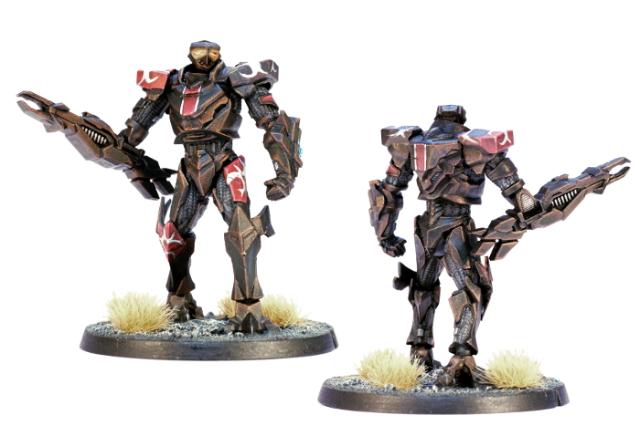
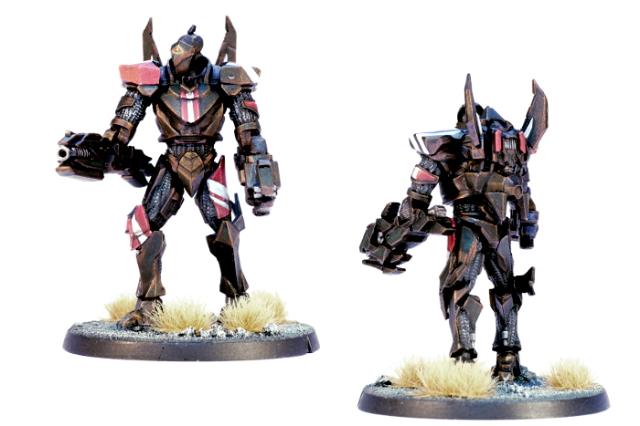
Each suit is assisted by sophisticated motion predicting micro-servo motors to give them unparalleled strength and mobility, moving with ease through dense terrain and being able to punch holes through conventional armour. Every suit also boasts a wealth of sensors including friend or foe recognition, communications frequencies, target acquisition and capability calculation, capable of identifying weak points on the target and providing suggestions as to what weapon to attack it with. All suits are slaved with targeting and intelligence information from the insertion ships in orbit, providing a strategic overview, co-ordination between strike teams and immunity to ambush.
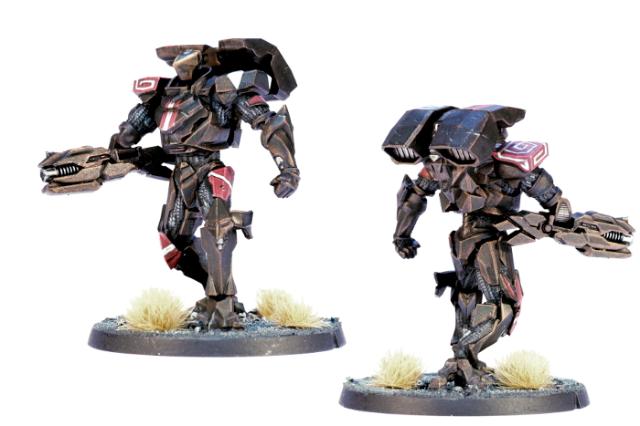
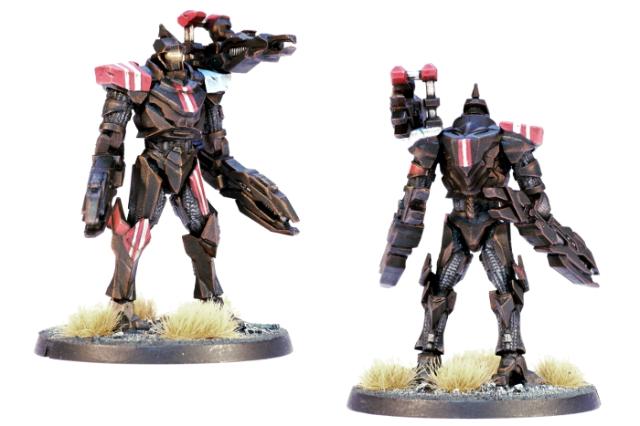
The suits are powered by a miniature tritium energy cell, and are good for several months without recharging. This powers all suit subsystems including medical diagnostic systems which will seal over wounds including resorting to removal of limbs if necessary, and supply painkillers, stimulants and medication as required. The armour will also recycle bodily waste and their occupants can survive for weeks without resupply, although the experience would not be particularly pleasant.
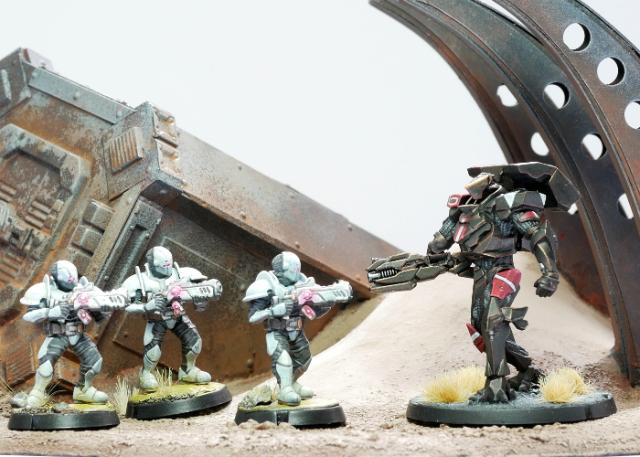
The standard 'Militus' class suit forms the core of most Artarian fire teams. They can be equipped with a range of different, high-powered weapon options and are also often fitted with protective field generators or jump packs for extra mobilty.
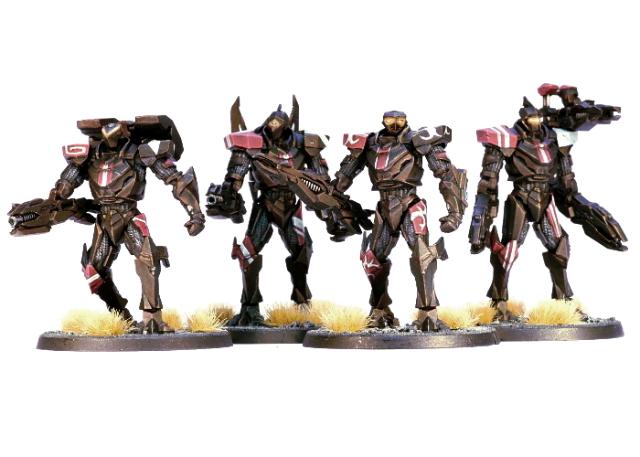
This kit contains a single, mulitpart Militus suit on one plastic sprue, along with a 45mm plastic base.
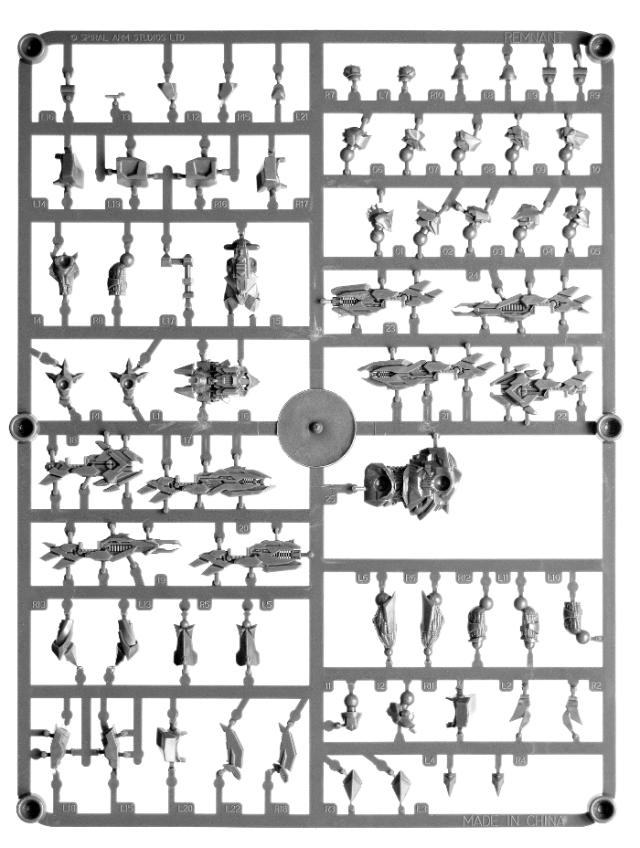
To get you building, you can find assembly instructions in PDF format here.
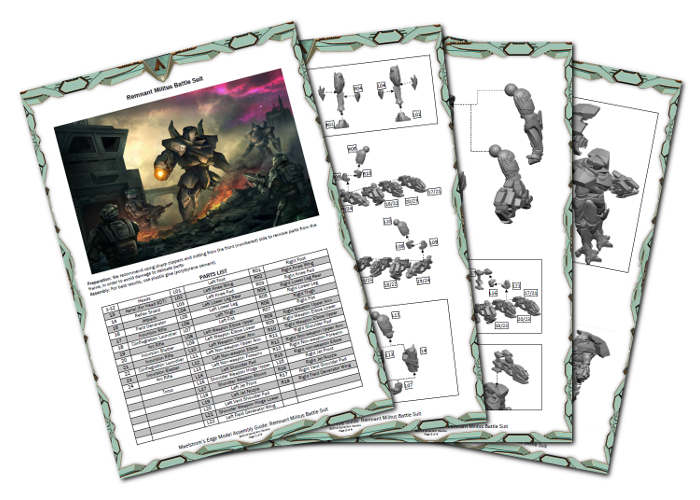
The Militus kit is available now from the Maelstrom's Edge webstore. Faction rules are still being finalised, as the other models for the Remnant are still being developed, but will be added to the website as soon as they are ready to go!
Painting Tutorial: Aged Copper
Posted on Monday Apr 01, 2019 at 05:00pm in Tutorials
- by Iain Wilson
For a very long time, I tried to avoid painting anything copper, as none of the copper paints I had tried ever looked quite right. Since I started getting a little more adventurous with my terrain building, though, it became harder to avoid having to figure something out that I could be happy with, and so eventually I started experimenting again to see what I could work out. This week, I'm sharing a quick tutorial showing the method I settled on.
For my example piece, I'm using a piece of a 13mm drip irrigation fitting, with the large pipe fitting from the Maelstrom's Edge terrain sprue as a handy stand for it.
The first step is to undercoat with a medium green colour - I'm using Army Painter Army Green spray, but pretty much any green will do. This just gives a bit of a green tint anywhere that the copper paint winds up a little thinner, so the actual colour isn't too important.
Next, paint on two coats of copper. Here, I've used some old (very old) Citadel Beaten Copper, but again you should be able to use whatever copper you have. Copper fittings tend to vary considerably in colour, so there's no 'right' shade to look for, other than what looks right to you.
The reason that copper paint tends to not look right is that unless it's polished (which brush-on copper paint doesn't convey) copper generally isn't actually metallic copper coloured. It's more of a dull, coppery brown. So, over the copper, paint a generous slathering of Army Painter Mid Brown wash and leave it to dry.
You could leave it there, with perhaps a light drybrush of copper over the top to pick up some highlights, or carry on and add some verdigris by drybrushing with a suitable blue-green colour. As with the copper itself, verdigris can range from a pale green through to more of a turquoise colour, so use whatever colour suits the look you want. I've used Vallejo Model Colour Emerald here, mixed with just a touch of white and drybrushed wherever it looks appropriate. You can leave as much or as little of the copper brown showing through as you want to get the desired look.
Finally, you can add some scratches with thin lines of black, highlighting the bottom edge of the line with copper. Light highlights and lines of copper without the black can also be used to show shallower scrapes and scuffs.
And that's about it. Go forth and copper up your terrain to your heart's content!
You can pick up the Maelstrom's Edge boxed game and model range from the webstore here.
As always, feel free to pop along and share your work, or ask any Maelstrom's Edge- or hobby-related questions on the Comm Guild Facebook page!
For other Maelstrom's Edge modeling articles, including tutorials and walkthroughs of a wide range of different building and miniature projects, check out the Hobby section of the Maelstrom's Edge website here.
Tags: painting terrain tutorial walkthrough
Terrain Spotlight: Alien Forest using Silicon Aquarium Plants!
Posted on Monday Mar 25, 2019 at 05:00pm in Tutorials
- by Iain Wilson
While there is a steadily growing range of awesome terrain on the market these days for sci fi wargames, one curious gap is the general lack of alien plantlife, which results in a vast majority of 'forest' type terrain being represented on the table by variations of the same, standard green trees. This week, I'm venturing outside the shady, green box, and creating an alien forest setup using silicon aquarium plants!
Aquarium plants come in a pretty vast range of different styles, sizes and colours, so can be an invaluable source of alien flora. The plants I'm using here are some sort of anemone-looking thing made from silicon and mounted in pairs or triplets on resin rocks. You could just as easily use whatever other plants you feel like (or can find in your local aquarium supply store!), but I really liked the look of these.
Forest bases need a base (obviously!), so I cut half a dozen out of 5mm masonite. I used a scroll saw with the blade set to a 30 degree angle for this, to get nice wobbly edges, and then sanded them down smooth. You could do the same with a jigsaw, or a coping saw if you prefer to avoid power tools.
Onto each base, I glued two or three clumps of 'trees' with superglue, leaving them in the resin rocks so that I didn't have to make up some sort of alternative base for them. This also helps to give them a little more height, and adds a bit of extra texture to the forest bases.
To stretch out my collection of plants a bit, and also to help break up the identical clumps, I cut through some of the resin rocks with a razor saw to split up the tree clumps.
The cut edges of the rocks were then concealed behind stacks of foamed PVC, cut from scraps leftover from a previous project. You could also use foamcore or cardboard for this (although the PVC is a bit more durable and less likely to delaminate from use) or putty or filling plaster to sculpt up a replacement rockface.
From there, I slapped a generous coat of PVA glue on each base and sprinkled on a sand/gravel mix, leaving the glue to dry before tipping off any excess sand that hadn't stuck. I also applied a generous spray of matte sealer, both to help hold the sand down and to kill a little of the shine on the silicon plants.
To paint, I glopped on a generous coat of a medium brown as a base coat - I used a Mont Marte Burnt Umber artist's acrylic for this, with the intention of matching these bases to the air conditioner fitting bunker that I made last week.
Over the brown, I drybrushed a taupe colour ('Fawn', another artist's acrylic).
The largest of the bases had some extra space left on it, so I added some young growth using some clipped pieces of plastic rod, painted up with red and yellow to match the plants.
And that's pretty much it. If you want a more over-grown look to your forests, you could easily put the 'tree' clumps closer together, or add extra undergrowth using other, smaller plants. There's a bit of a balance to find with area terrain like this, though - You want it to look good, but you also need to be able to put models in it, so I prefer to keep things fairly simple to improve their function on the table. An alternative compromise is to mount the trees onto the base with magnets instead of gluing them in place. This lets you add some extra layers of detail, while being able to selectively pluck parts of the forest out of the way as necessary to place models in there. For now, though, this is my forest all together on the table:
Feeling like assembling your own tropical alien paradise? As always, feel free to pop along and share your work, or ask any Maelstrom's Edge- or hobby-related questions on the Comm Guild Facebook page!
You can find the Maelstrom's Edge boxed game and model range in the Maelstrom's Edge webstore here.
For other Maelstrom's Edge modeling articles, including tutorials and walkthroughs of a wide range of different building and miniature projects, check out the Hobby section of the Maelstrom's Edge website here.
Spiral Arm Studios at Salute 2019
Posted on Friday Mar 22, 2019 at 08:23pm in General
Salute 2019 is on Saturday, April 6, 2019 at Excel London, run by the South London Warlords - If you're going along, come down to booth TK16 and say hello, and check out our shiny new plastic!
Tags: preview salute2019
Terrain Spotlight: Bunker from an Air Conditioner Fitting
Posted on Monday Mar 18, 2019 at 05:00pm in Tutorials
- by Iain Wilson
Apparently even when I'm looking for something else completely, the terrain bug is difficult to avoid. On a completely unrelated trip through the hardware store for a change, I came across a rack of plastic air conditioner ducting that included a bunch of pieces that immediately jumped out as potential building fodder. Before you could say 'Get to the bunker!' I was on my way home with fingers just itching to break out the tools. The end result was a brand new ground-level access for a bunker complex!
The piece that I chose started out life as a 100mm ceiling cap, which is apparently something to do with air conditioners - I'm taking the word of the label for that! I love the idea of buildings that serve as an entryway to larger complexes below ground, and the shape of this fitting looked perfect for an atrium bunker leading to a staircase or angled lift shaft.
As the type of plastic used was shiny and of indeterminate pedigree, I started out by removing the label and giving the whole thing a light sand with fine grade sandpaper to remove the glossy outer layer. This helps the glue and paint to stick later.
The fitting is made of two separate pieces that clip together along the sides, which made cutting window holes a little easier - I popped the pieces apart, and used a shutter window from the Maelstrom's Edge terrain sprue to trace around for the hole, with one vertical edge running along the seam. Then I cut along the top and bottom of the marked hole with a razor saw, and scored the other vertical side and snapped the resultant scrap piece out of the hole. This was repeated on the other side, and again on the front for a door hole, using the armoured door from the terrain sprue as a guide.
I glued the windows and door in place using an 'all plastic' glue combo (a two-part setup that includes a tube of superglue and a 'primer' pen that is used first to help the glue stick to unusual plastics). I also added a strip light above the door for a little extra visual detail, and to cover over the screw hole that was there.
To fill in the roof, I cut two pieces of 2mm foamed PVC to the right shape to fit in the cavity. In one of these I cut a square hole for the hatch from the terrain sprue. The two pieces of PVC were then superglued together, and the hatch glued into the hole.
The fitting has a couple of handy ridges running around in the top cavity at a perfect height to form a balcony once the PVC section was glued and dropped in to sit on them. At this point I also glued the structure down onto a piece of masonite cut to an appropriate size and shape, and filled in the seam on the fitting with a little putty.
To paint, I started out with a coat of Rustoleum brown primer.
I wanted some light texture over the non-metal parts of the bunker. For this, I used a terracotta paint found in the paint section at my hardware store. This is generally used on plastic plant pots to make them look like they're made of terracotta, and has a really fine grit mixed through it to give it a sandy feel. I used a large brush and dabbed this on rather than brushing, to avoid brushstrokes showing up when I drybrushed over it.
The terracotta coat was a little patchy when it dried, with the dark brown basecoat showing through a bit darker than I wanted, so I went over it with a coat of Burnt Sienna craft paint. While that was drying, I also went over the base with a generous layer of PVA glue and sprinkled on a coarse sand and gravel mix.
The bunker was then drybrushed with a mix of Burnt Sienna and a taupe colour (actually called 'Fawn' on the bottle). The metal parts were given a heavy drybrush with P3 Pig Iron and then a generous wash with Army Painter Dark Tone, and the base was painted with a dark brown (Burnt Umber) craft paint.
Finally, the base was drybrushed with some more Fawn, and the lights painted with Citadel Ultramarine Blue, drybrushed with Ice Blue and White.
I also added a building number on the back slope, using a stencil printed out on paper and cut out with a hobby knife. I dabbed on Vallejo Light Grey with a large brush, and then a layer of white, trying not to make it too neat so that it would look a little weather-worn.
A shot of the roof:
And that's it - ready for the table!
Build your own bunker by picking up the Maelstrom's Edge terrain sprue, along with the rest of the Maelstrom's Edge model range from the webstore here.
As always, feel free to pop along and share your work, or ask any Maelstrom's Edge- or hobby-related questions on the Comm Guild Facebook page!
For other Maelstrom's Edge modeling articles, including tutorials and walkthroughs of a wide range of different building and miniature projects, check out the Hobby section of the Maelstrom's Edge website here.
Tags: buildings bunker modeling spotlight terrain terrainsprue walkthrough
Painting Tutorial: Weathered Signs using Photo Paper Decals
Posted on Monday Mar 11, 2019 at 05:00pm in Tutorials
- by Iain Wilson
Marking your buildings and other urban features with signs, graffiti and other appropriate splashes of colour is a great way of adding some touches of realism to your wargaming terrain. This week, I thought I would share a simple technique for creating faded and worn signs and markings using decals made from photo paper!
This technique won't get you bright, new looking signs - for that, you can use regular decals, or print your sign out on paper and glue it in place. What we're aiming for here are signs that have been out in the elements for a while, and are battered, chipped and faded.
Start by drawing up the design you want to apply to the building in your drawing program of choice (I use Gimp). The final applied image will be duller than your original, so you may need to experiment a bit to find the right level at first - If you want a fairly bright and legible sign, use bright colours. Use more muted colours for a more faded effect.
You will also need to flip the image so it is a mirror-image. Then print onto gloss photo paper, and cut out the design using a sharp hobby knife or scissors. Leave a tab of extra paper on one side, and just score lightly along the edge of the image on the tab side.
Apply a thin layer of superglue to the surface of the image. You need to keep this thin enough that it won't squeeze outside the bounds of the image when you press it onto the terrain surface. Don't worry if you don't get the image covered perfectly, as this just creates some handy chipping on the final image.
Press the image face-first onto your painted surface and hold it in place until the glue has had a chance to set.
Grab the excess paper tab and gently peel the paper off. It should peel away leaving the ink and a very thin surface layer of the photo paper behind. Gently scrape the paper layer away with a finger nail to expose the coloured surface beneath.
For any remaining scraps of thin paper left behind, you can rub gently with a damp fingertip to clean then away. The moisture will make your image look brighter for a moment, and white parts may go transparent, but it will fade again as it dries.
If the end result is a little too faded, you can pick the colours up a little by painting on a thin layer of gloss varnish. It won't make a huge difference, but will brighten things up slightly.
From there, you can go ahead and add other detailing and weathering to your terrain as desired. See my guide to sponge weathering here, or the slightly more advanced salt weathering technique here.
As noted back at the start, while the end result is intended to be faded and weathered, you will get a brighter end result if you use stronger colours to begin with. Black shows through best of all, so you can add extra definition to the image by adding thin black borders around everything.
Give it a go! Feel free to share your efforts, or ask for help on the Comm Guild Facebook page!
You can pick up the entire Maelstrom's Edge model range, including the terrain sprue used for the terrain in this article, from the webstore here.
For other Maelstrom's Edge modeling articles, including tutorials and walkthroughs of a wide range of different building and miniature projects, check out the Hobby section of the Maelstrom's Edge website here.
New resin release: Epirian SecDef Boostpack Specialists!
Posted on Wednesday Mar 06, 2019 at 05:00pm in The Epirian Foundation
This week sees the addition of some heavier firepower to SecDef Rapid Intervention Teams, with the release of SecDef Boostpack Specialists!
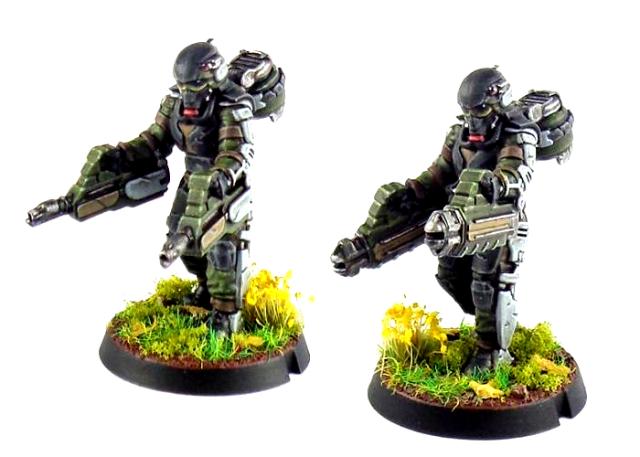
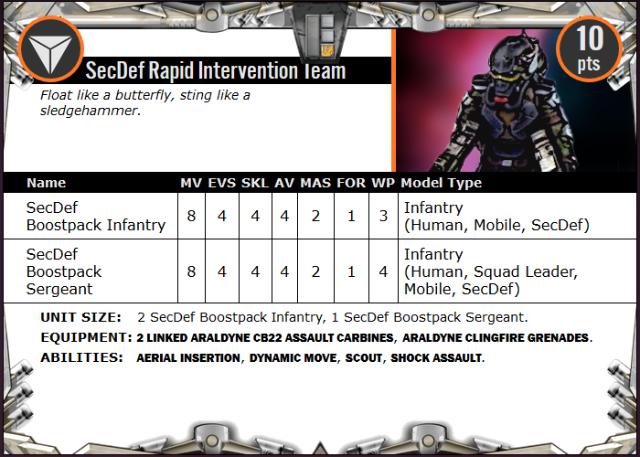
-Click here for the full rules card-
